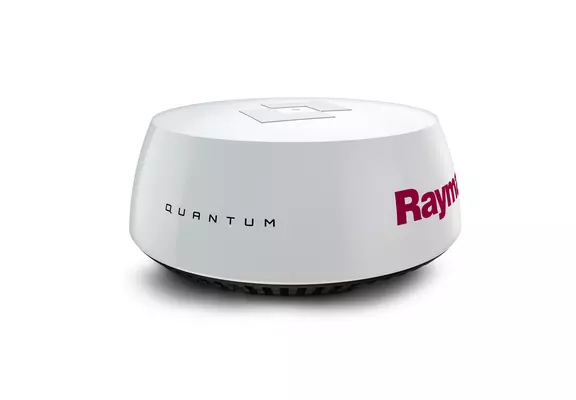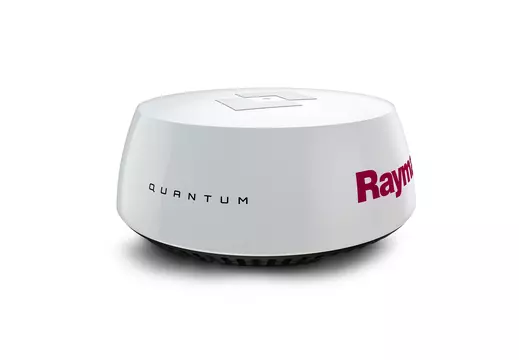


Wi-Fi only model
Supplied with a 10m power cable only
| General Specifications | |
|---|---|
| Dimensions: Diameter | Height | 541.0 mm | 209.5 mm |
| Weight | 5.6 kg |
| Supply voltage | Either 12 V dc or 24 V dc nominal |
| Operating voltage range | Minimum: 10.8 V dc | Maximum: 31.2 V dc |
| Power Consumption | Transmit mode (maximum): 17 W | Standby mode: 7 W | Sleep mode (applies only to radars connected via Wi-Fi): 2 W |
| Waterproofing | IPX6 |
| Operating temperature range | -10°C to +55°C |
| Storage temperature range | -25°C to +70°C |
| Additional storage conditions | Store upright; do not block vents on underside |
| Humidity | Up to 95% at 35°C |
| Maximum wind speed | 100 kts |
| Range scales | 1/16, 1/8, 1/4, 3/8, 1/2, 3/4, 1, 1.5, 2, 3, 4, 6, 8, 12, 16, and 24 nautical miles |
| Transmitter | |
|---|---|
| Type | X-band solid-state transmitter with pulse compression technology |
| Transmit frequency | 9354 MHz to 9446 MHz |
| Peak power output | 20W |
| Duplexer | Circulator |
| Pulse widths (3 dB) | 40 ns to 14.7 us |
| Chirp lengths | 400 ns to 22 us |
| Pulse repetition frequency | 920 Hz to 5900 Hz |
| Chirp bandwidth | Up to 32 MHz |
| Standby mode | Scanner rotation - OFF | Scanner transmission - OFF | Wi-Fi link - ON |
| Receiver | |
|---|---|
| IF frequency | 26 MHz |
| Noise figure | Less than 4 dB |
| Antenna | |
|---|---|
| Type | Patch array |
| Beamwidth (nominal) | Horizontal: 4.9° | Vertical: 20° |
| Polarization | Horizontal |
| Rotation speed | 24 rpm nominal |
| Target Tracking | |
|---|---|
| Target tracking | Tracking of 10 simultaneous Radar targets |
| Transmitter | |
|---|---|
| Type | X-band solid-state transmitter with pulse compression technology |
| CHIRP bandwidth | Up to 32 MHz |
| Standby mode | Scanner rotation - OFF, Scanner transmission - OFF, Wi-Fi link - ON |
| Duplexer | Circulator |
| Transmit frequency | 9354 MHz to 9446 MHz |
| Pulse repitition frequency | 920 Hz to 5900 Hz |
| CHIRP lengths | 400 ns to 22 µs |
| Pulse widths (3 dB) | 40 ns to 14.7µs |
| Peak power output | 20 W |
| Environmental | |
|---|---|
| Humidity | Up to 95% at 35°C |
| Additional storage conditions | Store upright; do not block vents on underside |
| Waterproof rating | IPx6 |
| Storage temperature range | -25°C (-13° F) to +70°C (158° F) |
| Maximum wind speed | 100 kts |
| Operating temperature range | -10°C (14° F) to +55°C (131° F) |
| Range scales | 1/16, 1/8, 1/4, 3/8, 1/2, 3/4, 1, 1.5, 2, 3, 4, 6, 8, 12, 16, and 24 nautical miles |
| Target tracking | |
|---|---|
| Target tracking | Tracking of 10 simultaneous Radar targets. |
| Conformance | |
|---|---|
| Standards (Canada) | RSS238 Iss. 1, Technical Acceptance Certificate |
| Standards (European Union & EFTA) | Radio Equipment Directive 2014/53/EU, Certificate of Opinion |
| Standards (Australia/New Zealand) | ACMA Declaration of Conformity, Compliance level 3 |
| Standards (USA) | 47CFR FCC Part 2 & Part 80, Certificate of Approval |
| Antenna | |
|---|---|
| Type | Patch Array |
| Beamwidth (nominal) | Horizontal: 4.9°, Vertical: 20° |
| Polarization | Horizontal |
| Rotation speed | 24 rpm nominal |
| Reciever | |
|---|---|
| Noise figure | Less than 4 dB |
| IF frequency | 26 MHz |
| Physical | |
|---|---|
| Diameter | 541.0 mm (21.3 in) |
| Weight | 5.6 kg (12.35 lbs) |
| Height | 209.5 mm (8.25 in) |
The Quantum family of radars both use a solid-state CHIRP pulse compression transceiver system which provides excellent short and long-range target detection. The Quantum radar provides a traditional radar presentation, while the Quantum 2 model offers Doppler target tracking. Doppler radar identifies moving targets on the radar scope and colorizes them red (inbound) or green (outbound) to call attention to them.
Doppler radar systems are instantly able to detect whether targets are getting closer to the scanner, or moving away, by measuring the minute shift in frequency of the echoes returning to the radar scanner. It uses this information to colorize these targets red (inbound) or green (outbound) to call extra attention to them. In busy waterways the Doppler colorization can reduce the workload on the radar operator, making it easier to determine which radar targets present a hazard and which do not.
A heading sensor is not required for Quantum 2 but is highly recommended. Adding a heading sensor to the radar allows it to perform better at slower speed (below 15 knots) particularly when tidal set and leeway are present. The presence of the heading sensor also enables target tracking capability using the radar’s MARPA/ARPA system, improves low and zero-speed rendering of radar/chart overlay, and enables a stabilized radar PPI presentation on the chartplotter or MFD (Multi Function Display). The Raymarine EV-1 or EV-2 autopilot sensor cores, or the AR200 augmented reality sensor module are recommended.
Quantum radar scanners work great for detecting small targets including lobster pots and fish trap markers, floating debris, kayaks and paddle craft, and navigation markers.
The Quantum 2 radar is available with either a standard marine white or stylish gloss black finish. The black radome cover is also available as a stand-alone accessory (part number R70989) that can be retrofitted onto any Quantum or Quantum 2 radar scanner.
Quantum and Quantum 2 radar scanners have a maximum range scale of 24 nautical miles, making them great for detecting and tracking weather at long-ranges. With any radar the distance at which you will be able to detect and track targets is dependent on both the height of your scanner above the waterline and the height of the target.
Quantum radars all offer user-selectable range scales of 1/16, 1/8, ¼, ½, ¾, 1, 1.5, 2, 3, 4, 6, 8, 12, 16 and 24 nautical miles. Quantum will automatically optimize its transceiver for best performance at the range scale selected.
All radars transmit electromagnetic energy at microwave frequencies which can be harmful, particularly to the eyes. For safety, we recommend that any radar be installed above head height, out of range of personnel and passengers.
Radar scanners should be mounted as high as practical above the waterline. Radar operates as a line-of-sight device, so a high mounting position will give better long-range performance. The radar is also best mounted above the head-level of crew and passengers, to avoid mechanical danger and minimize exposure to electromagnetic radiation.
The requirements for installation and operation of Raymarine radars may be subject to individual licensing of the equipment, operator, or vessel. You are strongly encouraged to check with the requirements of the licensing authority of your national administration. Your local Raymarine dealer can also advise on local and national licensing requirements.
Raymarine radars are ideal for use on rivers and inland waterways due to their excellent long and short-range target detection characteristics. The radar scope can also be presented in a heading-up presentation with a 1/3 or 2/3 offset that gives the radar operator maximum look-ahead visibility in these kinds of waterways.
In most cases, installing a new radar scanner will require the change-out of the radar scanner interconnect cable but there are exceptions to this. For example, Raymarine offers an adapter cable (A80308) that allows a Quantum or Quantum 2 radar to use the interconnect cable from any Digital or HD Digital radar scanner. Other options may be available. Please consult with your Raymarine installer or technical support for options.
In most cases new Raymarine scanners will fit on mounts that previously held another Raymarine radar scanner. The mounting pattern for radar scanners has been standardized for many years. There may be mechanical exceptions to this if changing from a radome-style scanner to an open-array due to the larger physical size and weight.
Raymarine radars are excellent tools for monitoring the weather. They can readily detect rain squalls, thunderstorms, and other atmospheric precipitation at long distances. Detecting and tracking weather at long distances can enable you to avoid harsh weather and make your time on the water safer and more enjoyable.
Radome-style radar scanners are often mounted to a sailboats main mast or foremast using a specially designed mast mount. The mount is typically rivited or bolted to the mast and offers a secure mounting point with excellent line-of-sight for the radar to operate. Optional guards are normally available to provide extra protection to the scanner from the impact of sails or rigging, if needed. These mounts are offered by Raymarine and from 3rd parties like Edson, Questus, ScanStrut, and SeaView.
Raymarine radar scanners come with a standard 2-year warranty covering both parts and labour. If you register your newly purchased radar on Raymarine.com within 90 days purchase your warranty coverage is extended to 3 years at no additional cost.
Most marine radar scanners are intended to be used with chartplotters or multifunction displays from the same manufacturer, with some small exceptions. Raymarine’s Quantum radar is compatible with the Orca Core 2 navigation system, as well as the The Q Experience Q2 Display.

| 1 | Quantum Radome |
| 2 | 10 m (32.8 ft.) Power cable |
| 3 | M8 mounting bolts with spring washers and flat washers x4 |
| 4 | Documentation |
| Manual | |
|---|---|
| Download Manual | Download Quantum radar manuals, declarations of conformity and mounting templates. |
| Software | |
|---|---|
| Download Software | Download the latest software for your Raymarine Quantum radar. |



